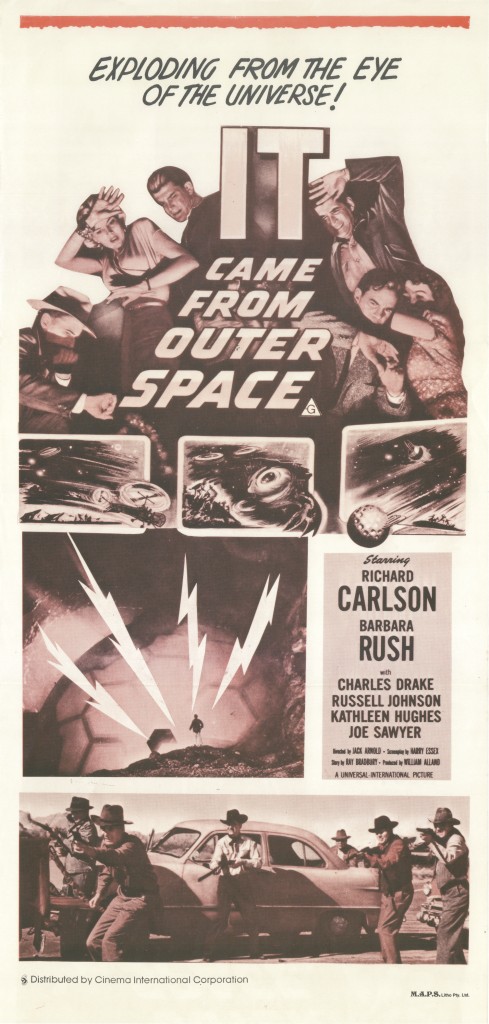 Our sixteenth choice of a potential classic in 2014 is a key movie for me, and, like all of our other choices, one which Barb has not previously viewed. Jack Arnold’s It Came from Outer Space (1953) is an incredibly original and important movie in the science fiction genre that establishes any number of archetypes and character models for the many alien and / or monster movies that would inevitably follow. And yet looking back more than six decades, It Came from Outer Space still stands apart from those films because of its aliens. For once during the 1950s, these aliens — who never identify their home or how they have traveled to land on Earth — have no interest in conquering our planet, stealing our natural resources, absconding with our women or inviting us to join some federation of worlds. This is perhaps the only film of the era to present aliens in the light of strangers who happen to stop by for a little while as they make their way to somewhere else more important. It’s as if their car breaks down on the spaceway and they simply need to repair a bad fuel pump or alternator before they head out on the road again. The sheer humility in the way our Earth and its civilization is casually disregarded by these space visitors is astonishing –yet refreshing. This is a movie that attains a rare perspective of our own little world because it looks at it and us through a hazy, cycloptic eye of a being from elsewhere with no concern nor responsibility for our existence or our future. But all that is revealed at the film’s climax. For most of the running time, the audience has no idea what the aliens are up to, or why they are here. Jack Arnold creates and sustains this mystery beautifully, with a flourish of artistic touches that mark this movie as one of the best of its kind ever made.
Our sixteenth choice of a potential classic in 2014 is a key movie for me, and, like all of our other choices, one which Barb has not previously viewed. Jack Arnold’s It Came from Outer Space (1953) is an incredibly original and important movie in the science fiction genre that establishes any number of archetypes and character models for the many alien and / or monster movies that would inevitably follow. And yet looking back more than six decades, It Came from Outer Space still stands apart from those films because of its aliens. For once during the 1950s, these aliens — who never identify their home or how they have traveled to land on Earth — have no interest in conquering our planet, stealing our natural resources, absconding with our women or inviting us to join some federation of worlds. This is perhaps the only film of the era to present aliens in the light of strangers who happen to stop by for a little while as they make their way to somewhere else more important. It’s as if their car breaks down on the spaceway and they simply need to repair a bad fuel pump or alternator before they head out on the road again. The sheer humility in the way our Earth and its civilization is casually disregarded by these space visitors is astonishing –yet refreshing. This is a movie that attains a rare perspective of our own little world because it looks at it and us through a hazy, cycloptic eye of a being from elsewhere with no concern nor responsibility for our existence or our future. But all that is revealed at the film’s climax. For most of the running time, the audience has no idea what the aliens are up to, or why they are here. Jack Arnold creates and sustains this mystery beautifully, with a flourish of artistic touches that mark this movie as one of the best of its kind ever made.
Astronomer John Putnam (Richard Carlson) and his schoolteacher girlfriend Ellen Fields (Barbara Rush) are enjoying a quiet evening at his house in the Arizona desert when the silence is ripped apart by a meteor crashing nearby. They goad a friend, Pete Davis (Dave Willock), into ferrying them out to the still-smoking crater by helicopter, and Putnam descends to see what he can see. What Putnam sees astonishes him: it isn’t a meteor at all, but a spherical spaceship with a hexagonal design. The door is open and Putnam gets a glimpse of what must be an alien . . . as well as evidence that another has left the ship. Then the door closes, causing an avalanche, and the spaceship is buried beneath tons of rock.
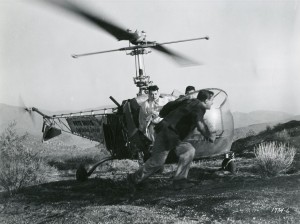
Neither Ellen nor Pete can believe Putnam’s description of a spaceship or aliens. Davis advises Putnam to keep his mouth shut when the press arrives, which occurs by car almost immediately. But Putnam believes his eyes and tells the truth, only to find his claims ridiculed in print and on the radio the following day. Even his collegiate colleague, Dr. Snell (George Eldredge), finds the idea of an alien landing in what sure looks like a meteor impact too fantastic to believe. What’s worse, local sheriff Matt Warren (Charles Drake) warns Putnam to leave Ellen alone; as a school teacher she has to remain respectable, and not be seen or identified with a local attention-seeker. Warren tells Putnam that the locals just don’t understand him, and what they don’t understand, they don’t like. The message is clear, but Ellen refuses to leave her man despite not blindly accepting his version of the situation.
But things begin to happen outside of the town of Sand Rock, mainly centering on two telephone line workers, Frank (Joe Sawyer) and George (Russell Johnson). Putnam talks to them the day after the meteor landing and Frank relates that the telephone wires seem to be singing with some undetermined noise, even letting Putnam listen to it. Then it’s gone. Later, the alien menace that did land in the crater traps Frank and George in a misty vapor — and the men that emerge from its grasp are no longer Frank and George. Putnam and Ellen meet George out in the desert and both of them are struck by how different, how cold and unemotional he has become. The couple departs and goes for the sheriff, but they cannot prove what they have seen.
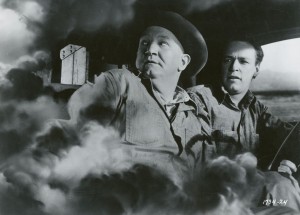
Life carries on quite normally in Sand Rock, except for a couple of burglaries of electrical equipment and the mounting suspicion by the sheriff, encouraged by Putnam’s crazy story, that all is not well. When Frank’s wife (Virginia Mullen) and George’s girlfriend (Kathleen Hughes) complain to the sheriff that their men are acting peculiarly, he is finally moved to action. Putnam, meanwhile, has been warned by the two aliens who have taken over the bodies of Frank and George to stay away. He is assured that the men have not been harmed, and that time is necessary for the aliens to do what they need to do before they leave. Putnam puts away his gun (no astronomer should travel the desert without one!) and trusts that he has been told the truth. He is more unsure than ever when he is informed by telephone that Ellen has been “taken over.” Not being able to keep things to himself, Putnam informs the sheriff of the situation, then watches as the sheriff stews, desperately wanting to take action.
Upon seeing Frank in town, the sheriff can wait no longer. Putnam slugs him so that Frank can get away, but that doesn’t prevent the sheriff from rounding up a bunch of locals and ambushing the fake Frank on a road out of town. Putnam rushes to the Excelsior mine to warn the aliens and is almost killed by one that looks like Ellen. Putnam confronts the aliens, including one that looks like him (!), and begs them to release the people they have taken. The aliens threaten to destroy the Earth if they are not left alone, but Putnam tells them he can hold off the posse if they make haste to leave. The aliens reluctantly agree, release the townspeople they have taken, and Putnam leads them out of the mine. He uses dynamite to seal the entrance just as the sheriff and his posse arrive, and everyone watches the alien ship blast off the way it came. Putnam assures Ellen that someday, when the time is right, the aliens will return to meet humanity in a proper fashion.
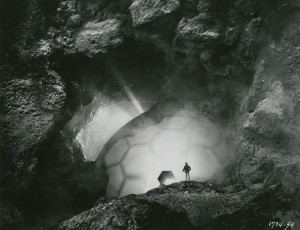
Jack Arnold stages It Came from Outer Space with all the menace he can muster. The aliens (which were never intended to be seen) sneak around the desert with shadowed purpose and sinister intent. Arnold exploits the desolation and alien landscape of the Arizona wilderness for all it is worth, heightening its spookiness with poetic, evocative dialogue written by Ray Bradbury. Frank describes how, since the meteor crash, the telephone lines seem to be “alive” with sound that was never there before. Shot after shot of cars and trucks moving along the desert roads are aerial shots, composed with telephone lines continually strung along in the foreground, humming with the strange theremin music composed for the film by Herman Stein, Irving Gertz and Henry Mancini. It’s as if the aliens have tapped into the telephone lines for purposes we cannot know or understand.
Ellen shivers when she looks out at the desert, seeing buzzards circle around and thinking how dead it is. No, murmurs Putnam, “It’s alive, and waiting for you. Ready to kill you if you go too far. The sun will get you, or the cold at night. A thousand ways the desert can kill.” It’s right after that when Putnam sees Frank up on a pole listening to the lines hum as they never have before. “After you’ve been working out in the desert fifteen years like I have, you hear a lot of things,” exclaims Frank. “See a lot of things, too. The sun in the sky, and the heat, all that sand out there with the rivers, lakes that aren’t real at all. And sometimes you think that the wind gets in the wires and hums and listens and talks, just like what we’re hearing now.” And then it’s gone.
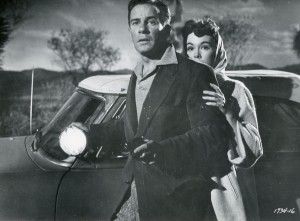
Evocative scenes like this provoke the sense that the primitive desert, formidable enough on its own merit, is portentous with alien menace and intrigue. That the people who live and work in the desert do so in the sure knowledge that they trespass in the realm of barbarous nature and must always remain vigilant. And that now, from the cold desolation of space, comes a new threat in the desert, one which frightens even the jackrabbits and screech owls and coyotes. An otherworldly presence that leaves a glittering trail in its wake. “Where are you?” asks Putnam as he stares at the empty wilderness, backed by ominous music. “What do you look like, what am I supposed to be looking for? I know you’re out there, hiding in the desert. Maybe I’m looking right at you and don’t even see you. Come on out!” This is the perfect approach to building suspense and reinforcing the motif that the aliens are indeed to be feared.
Bradbury’s premise, expanded by screenwriter Harry Essex, confirms that people fear what they do not understand. Just as the townspeople are wary of Putnam because they cannot relate to him, humanity itself is considered unwilling or unable to accept the horrible-looking aliens as (at least) equals in the universe. Even Putnam, the most open-minded, scientifically educated human in the region, shudders and turns away from the aliens when one reveals its true self to him. The aliens know enough of human nature to realize that friendly contact is impossible with beings who cower and scream when seeing them. Their choice, then, is to avoid contact. Mimic the beings of the world they happen to be stranded upon, grab what they need, and get the heck out of town before trouble erupts. It’s a wonderfully inventive, thoroughly reasonable approach to an alien encounter that was totally unexpected by audiences of the era.
Other than Klaatu’s friendly but rather threatening overtures in The Day the Earth Stood Still, movie audiences had recently been frightened by The Thing from Another World, The Man from Planet X, Phantom from Space and Invaders from Mars, so they were primed for this new shocker with the suggestive title. This would be the first “It” movie of the genre, soon to be followed by It Came from Beneath the Sea, It Conquered the World, It! The Terror from Beyond Space, and, eventually, just It! This was the first science fiction picture of the era to utilize a desert setting — one which director Arnold would return to in Tarantula and (as a writer) The Monolith Monsters. It established archetypal characters like the curious man of science and his pretty, socially respectable love interest; the stern, narrow-minded enforcer of law and even the loudmouth, naysaying friend. Because the film’s framework was Earth-bound, modestly produced and very relatable to audiences, it became very influential within the genre. Movies like Them!, Tarantula, The Beast with a Million Eyes, The Monolith Monsters, Attack of the 50-Foot Woman, The Black Scorpion, The Giant Gila Monster, The Beat of Hollow Mountain and The Beast of Yucca Flats all owe a debt of gratitude to It Came from Outer Space for introducing the desert milieu and demonstrating just how effective such an approach could be.
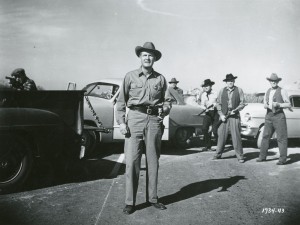
I enjoy Richard Carlson, Barbara Rush, Joe Sawyer and Russell Johnson in the film, but I think the finest performance is given by Charles Drake as Sheriff Matt Warren. The sheriff has a paternal interest in Ellen and warns Putnam more than once to keep Ellen away from public ridicule. His instincts are slow, but once he gets riled up he is a forceful personality. Drake is completely natural in the role and elevates the drama, especially in the scenes where Warren and Putnam are anxiously waiting in the sheriff’s office for something to occur. It is then when Warren gives his little speech about the most dangerous temperature. “Did you know, Putnam, more people are murdered at ninety-two degrees Fahrenheit than any other temperature? I read an article once — lower temperatures, people are easy-going. Over ninety two, it’s too hot to move. But just ninety-two, people get irritable.” It’s just small talk from one bored guy to another on a hot day, and nowhere is it ever indicated that Sand Rock’s current temperature is 92 degrees, yet that dialogue sets a perfectly edgy tone to a scene already begging for action to commence. It’s my favorite piece of dialogue in the whole film.
Unusually for such a science fiction / horror film, no people are killed, and the body count of the aliens reaches just two. Alien slaughter isn’t the point; a few months later The War of the Worlds provided plenty of that. The story expounds upon the fear created by the situation in just a few people — remember, most of the townsfolk are never aware of what is going on around them, other than seeing Putnam’s account of “Martians” ridiculed in the newspaper. The only people who really know what is occurring are Putnam, Ellen, the sheriff and the people whose personas have been duplicated by the aliens, and are being held captive by them. The story focuses on Putnam’s struggle to trust the aliens and the sheriff’s struggle to understand and resist taking action. As opposed to the other alien-themed movies of the time, this one keeps the aliens in the background for as long as possible and advocates a tempered approach to the unusual situation.
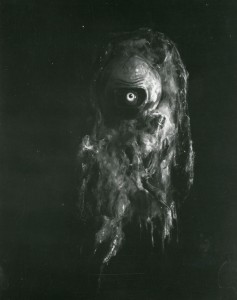
Jack Arnold told me in a 1980 interview I conducted with him that the plan was, in fact, to keep the aliens in the dark entirely — to not reveal them at all and let the audience’s imaginations to fill in the blanks.
“And I wanted the audience to use their imaginations as to what they (the aliens) would look like. It was against my, not orders, but my feelings that we shouldn’t show it at all. I only had planned to show about a three-foot cut of it, just like, almost peripheral, you know, so that you couldn’t quite make out what it was, but you knew you saw something but you couldn’t quite make out what it really was. My argument was that no matter what we constructed it’s gonna look phony . . . So I said if you’re gonna use it, can I avoid shooting it in long cuts so that we only have a few feet to play with, so you couldn’t stare at it long enough to figure out what the hell it was. It made what frightened them more frightening, and made the point of the film, which is that we as a human race are frightened to death of anything that’s different than we are. Our first instinct is to kill.”
I asked the director to expound on why his movies, beginning with It Came from Outer Space, didn’t follow the popular format regarding marauding monsters on the loose. “Because I tried to point out, in one way or another, that we would never give anything a chance. We would kill first and ask questions afterward. Beneath the veneer of civilization there is a barbarism — These creatures, whoever came from outer space, were benign and not hostile, unless provoked. Most everybody was making monsters out that kill senselessly. I had a choice. My choice was the other. Since I was surrounded in that era by pictures of that kind, mine were different. And I wanted to be different from anybody else.”
In terms of directing, Jack Arnold was different from everybody else, and better, too, in his field. Robert Wise had done The Day the Earth Stood Still, but the big name directors wouldn’t touch sci-fi in the 1950s. It was considered beneath them. That opened the door for people like Jack Arnold, Eugene Lourie and Kurt Neumann to make their marks. Arnold was the best of the bunch, following his work on It Came from Outer Space with classics like Creature from the Black Lagoon, Tarantula and his masterpiece, The Incredible Shrinking Man, as well as minor efforts Revenge of the Creature, Monster on the Campus and The Space Children. He also directed the Metaluna segments of This Island Earth and non-sf fare such as The Mouse That Roared and High School Confidential!. He was a heck of a director, especially within the science fiction universe, where he aspired to do his own thing his own way.
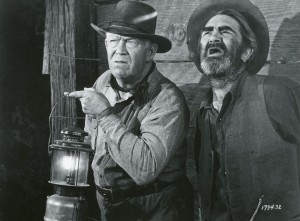
One other element was employed to make It Came from Outer Space both exciting and new; it was filmed in 3-D. Bwana Devil and House of Wax had proven to the Hollywood studios that 3-D was not only viable but profitable, so Universal chose this tale to utilize the process. Jack Arnold used two cameras side by side — one of them upside down — to capture the images, which were then projected in synchronization at specially-equipped theaters. Arnold planned his 3-D effects carefully and subtly; note the way John Putnam swings the telescope in the opening scene, or the way that Sheriff Warren reaches for his gun belt at his office, or the ghostly hand that reaches out toward Ellen in the desert. Many of the desert scenes are accomplished in deep focus, with scrub, Joshua trees, cacti and even telephone poles used at various positions to establish levels of dimension that look fine in flat prints but gain realistic depth in the three-dimensional process. There are a couple of obvious shock shots — the boulders raining down in the crater, the close-up of the alien and its distended eye when it forces vehicles to stop in the road, the close-up of the helicopter from beneath as it lands — but Arnold wanted the 3-D to be organic rather than forced, and more of the effects are delicate rather than obtrusive.
With his deft handling of the subject matter, the desert filming and the 3-D effects, Arnold became Universal’s resident sci-fi expert. He was given a story and a budget and then left alone to make his movies. He filmed Creature of the Black Lagoon and its sequel, Revenge of the Creature in 3-D, as well as the murder mystery The Glass Web, before the process was abandoned by Universal and the other major studios. But It Came from Outer Space is so good it doesn’t need 3-D to succeed.
Is It Came from Outer Space a classic? Of course! I’ve outlined much of its historical significance above, but none of that really matters to someone sitting down to watch it for the first time. All that matters is whether it is an entertaining film. It sure is! Except for the weird blade seen topping the meteor when it crashes (along with its all-too-visible wires and, just for a second, a mirror contraption along the left side of the screen) this film is a beautifully rendered composition of desolate landscapes and shadowy places where emotionless aliens hide from view. The story is very literate and suspenseful, becoming ever more engrossing as the truth regarding the aliens is revealed. It is thoughtful, intelligent and surprising. It’s funny, too, with one big laugh as Ellen opens the door only to find herself face-to-face with a rather young space alien. Steven Spielberg has said that this film was a prime influence on his pet project Close Encounters of the Third Kind. Yes, It Came from Outer Space is a film classic. ☆ ☆ ☆ 1/2. 17 November 2014.
